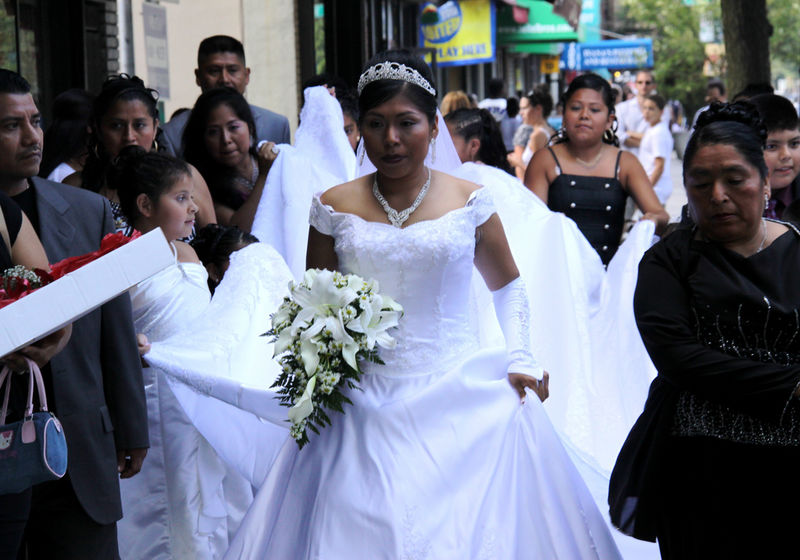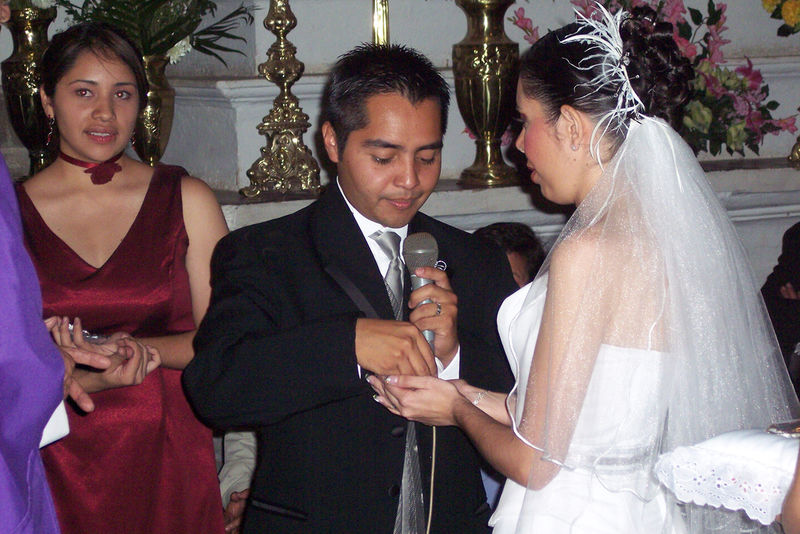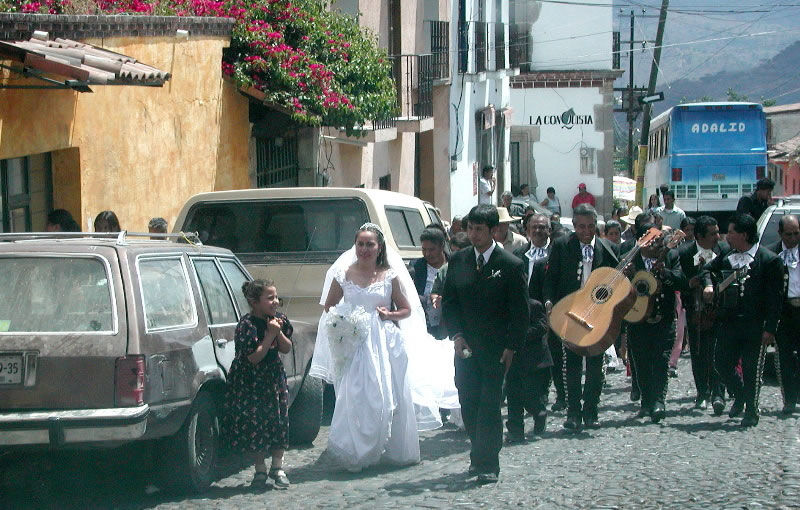Mexican Wedding
Mexican weddings are steeped in tradition, starting with the groom formally proposing to the bride's family and involving important roles for godparents who give symbolic gifts and sometimes help cover wedding costs. The wedding ceremony features unique customs such as the groom giving 13 golden coins to the bride, the use of a "lazo" to symbolize unity, and the bride praying before the Virgin of Guadalupe. Celebrations include lively receptions with traditional dances like the "money dance" and "sea snake," a variety of Mexican dishes and cakes, and often continue with an extra party called "tornaboda" featuring stamina-boosting foods.
Mexican Wedding
Many Mexican families are still very much patriarchal. It is the father who gives the final approval on the wedding. His action is known as "la pedida" or "father's approval". It is a tradition that the groom-to-be and members of his family visit the bride's family. There he formally proposes the woman of his life.
After that preparations for the wedding may begin.
The Godfathers (Padrinos) and Godmothers (Madrinas) are very important characters at every Mexican wedding. They have several duties. They are witnesses at the wedding ceremony in the state office. During wedding ceremony they give several presents to the bride and groom. These presents are a prayer book, rosary and a pillow. Padrinos, madrinas, family members and friends sometimes pay part of wedding costs. Traditionally it is the bride's father who pays most wedding costs.

Wedding dress ("vestido de novia") can differ from region to region. In the state of Oaxaca located in the south of the country wedding dresses have lot of lace and other decorations. A dress in the region of Zinacantan in the state of Chiapas even includes goose feathers. Before the arrival of Spaniards to Mexico these feathers symbolized economic power and beauty.
A bride traditionally sews yellow, blue and red stripes into her underwear for luck. These ribbons should provide the couple with enough money and food and make the life very passionate. Nowadays some brides only wear a blue garter.
A groom in Mexico usually wears a traditional shirt called "guayabera". This shirt was first designed about two centuries ago. Today it appears in many variations.
During wedding ceremony the groom will give 13 golden coins ("las arras") to the bride. These coins represent Christ and 12 apostles. He then gives her a special box in which these coins are kept. The coins are blessed by the priest. They symbolically show groom's dedication to support the bride.

One of the most famous symbols present at the Mexican wedding is the "lazo". This string is tied in the shape of 8 between the bride and groom immediately after the wedding ceremony. Lazo can be made of various materials like beads or precious stones, for example. It represents the unity of two human beings.
At end of the wedding ceremony bride prays kneeling in front of the altar dedicated to the Virgin of Guadalupe.
After the wedding ceremony a procession involving the happy couple, their parents, families, friends is created. There is a band performing live music. Often it is traditional Mariachi music. The group goes to the place where the wedding reception will be held. Sometimes the wedding group also includes a donkey ("burro") carrying a bottle of tequila or wine.
A Mexican wedding reception is a very lively event. It includes numerous traditions. One of them is "the throwing of the bouquet" ("lanzar el ramo") where a bride throws a flower bouquet towards a group of single women who dance around her. The woman who catches flowers is going to get married next.
Some weddings have a piñata too. It is filled with candies. It gets broken by the children attending the wedding reception. Candies are then shared among guests.

All the people at the wedding reception dance a lot. When dancing the first dance the newlyweds are surrounded by other dancers holding hands.
There is a dance that has an extra purpose to help the newlyweds in the first months of their life together. It is so called "money dance" where dancers move towards the couple and give them some money.
A famous dance present at most Mexican weddings is the "sea snake" ("la vibora de la mar"). A bride and a groom each stand on a chair. They are connected with a veil or any other piece of cloth they are holding in their hand. To make a bride and a groom safe from falling off the chair there is a person standing behind them. The area between bride and groom is wide enough for the dancers holding their hands in a sort of chain can move through.
There are many meat and vegetable dishes prepared for the wedding reception. Traditional Mexican delicacies like tortillas or tamales are part of the wedding menu too. Many Mexican wedding cakes are made of fruit. They are usually soaked in rum. A "tres leches" (three milks) cake is often made for the occasion. Why three milks? Three type of milk (evaporated, condensed and heavy cream) are used in the preparation of this cake.
Many Mexicans can not imagine a wedding without a cake called "pastel de almendra" which is made of almonds.
The same as in most of the world Mexican drink lot of alcoholic and other beverages. Some parts of the country are famous for rather unusual drinks prepared for the wedding reception. The state of Oaxaca is known for the chocolate drink that is served with a piece of special bread.
The end of wedding reception does not mean the end of partying. Some Mexicans organize sort of extra party known as "tornaboda". There is a special menu with food that should provide people with an extra stamina to party. This menu is called the "menu that should wake up the dead" ("levanta muertos menu"). This menu includes pork, tacos, "pozole" soup, beer etc.
References
What every Bride needs to know about Mexican Wedding Traditions
http://www.theyucatantimes.com/2015/01/what-every-bride-needs-to-know-about-mexican-wedding-traditions/
Tres leches cake
http://en.wikipedia.org/wiki/Tres_leches_cake
Carmen Laborin, Mexico's Wedding Rituals and Traditions
https://destinationweddingsmexico.wordpress.com/2012/05/24/mexicos-wedding-rituals-and-traditions/
Wedding Traditions and the Meanings (Part Deux)
https://weddingswithyesenia.wordpress.com/2012/08/09/wedding-traditions-and-their-meanings-part-deux/
Audrey M. Jones, Mexican Wedding Traditions
http://weddings.lovetoknow.com/wiki/Mexican_Wedding_Tradition
Image(s)
Groom gives "las arras" to the bride (photo by Christian
Frausto Bernal, Flickr)
https://www.flickr.com/photos/cfrausto/74223800/
Mexican bride (photo by Chris Goldberg, Flickr)
https://www.flickr.com/photos/chrisgold/4811318912/
Mexican wedding procession (photo by Tim & Annette Gulick,
Flickr)
https://www.flickr.com/photos/gulicks/16642934/
Creative Commons - File:Mariachis CDMX.jpg